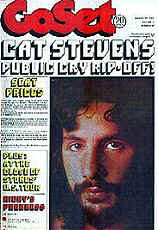Go-Set
Go-Set was the first Australian
History
Foundation: 1964–1967

In 1964,
The first edition of Go-Set, dated 2 February 1966, was published with Schauble cited as editor because Frazer, a medical student, asked to be listed in the low-key role of designer and Panther, who had not registered for the military draft, was described as a feature writer.[2] The first issue showcased Tom Jones (see right) and Herman's Hermits interviewed by Panther and photographed by Colin Beard at Palais Theatre, St Kilda. Initial sales were low, about 3000 to 5000 but Issue 3, which covered The Rolling Stones tour in Melbourne and Sydney, doubled their sales.[2]
Initially Go-Set was intended for Melbourne distribution only. A book distributor, Bill Robinson, managed circulation throughout
Ian "Molly" Meldrum wrote his first story for Go-Set in July 1966,
Go-Set had become the indispensable chronicle of the local scene, described by Jim Keays, lead singer of The Masters Apprentices, as the Australian music bible.[5] From 5 October 1966, it featured Australian singles charts[7] and international charts, local state gig listings and record reviews.
Go-Set developed an international focus when, in a promotional arrangement with
In America they covered the
Offshoots: 1968–1973

Over its nine-year history there were many significant additional contributors including
Ian "Molly" Meldrum wrote a weekly column for Go-Set from August 1966 until its demise in 1974. His writing style represented his own
Nimmervoll, an architecture student, started with Go-Set as the compiler of the national Top 40 charts, beginning in February 1967. He then wrote feature stories and record reviews, and in December 1969 began editing Go-Set's
Founders, Schauble and Beard had left by February 1969 and Frazer became editor and publisher; Jon Hawkes joined as co-editor in April. Frazer launched two monthly counter-culture magazines, Revolution, which lasted from 1 May 1970 – 1 August 1971, and High Times, co-founded with Macy McFarland and Pat Woolley, which published August 1971 – 1 January 1972. Frazer left Go-Set in February 1972 (after Waverley Press took control of the company) and founded The Digger in September 1972. Frazer also launched the Australian edition of Rolling Stone magazine first as a supplement in the fourth issue of Revolution, then as a fully-fledged magazine in early 1972. Frazer left Rolling Stone Australia in 1974 but continued with The Digger until December 1975, after which he moved to United States.[citation needed]
Go-Set reached its peak in circulation, with 72,000 copies per week, in June to December 1970. After Frazer left as editor in 1972 to concentrate on The Digger, Piotre Olszewski was editor from May to July before Nimmervoll took over with Meldrum as co-editor. Nimmervoll remained until December 1973 when Sungravure Ltd bought Go-Set and relocated its headquarters to Sydney.[2]
Last edition and beyond: 1974–current
In December 1973, Nimmervoll left Go-Set and founded Juke Magazine in 1975. Subsequently, he established Take 40 Australia and, since 2000, he has edited HowlSpace, a website detailing Australian rock music history.[10] He is also an author of books on the same subject.[11]
By January 1974, Go-Set was sold to Sungravure Ltd (part of the
Meldrum remained to the last issue and became an integral part of
Frazer has edited and managed political magazines in America and, with Jim Hightower, published The Hightower Lowdown, a progressive political newsletter, from 1999 through 2013, after which he returned to Australia.[12]
In 2012, Brett published
Go-Set Australian national charts
From March 1966, Go-Set published radio station
In May 1974, the first Kent Music Report was published by David Kent, which became Australia's official national charts. The Kent Music Report appeared just before the last Go-Set charts were published on 24 August 1974.[17]
References
- ^ Barry McKay (2006). "Where to find publicly available copies of Go-Set". Pop Archives. Retrieved 27 March 2009.
- ^ a b c d e f g h i j k David Martin Kent (September 2002). The place of Go-Set in rock and pop music culture in Australia, 1966 to 1974 (PDF). University of Canberra (MA). Canberra, A.C.T. Archived from the original (PDF) on 4 September 2015. NOTE: This PDF is 282 pages.
- ^ ISBN 978-1-921332-11-1. Retrieved 27 March 2009.
- ^ a b Kent, David M. (2000). "Go-Set: Life and Death of an Australian Pop Magazine". Retrieved 28 August 2008.
- ^ a b Jeffrey Turnbul. "Go-Set Australian Chart Website: What was Go-Set". Archived from the original on 23 September 2018. Retrieved 27 March 2009.
- ^ "Top 40 TV". Televisionau.com. Retrieved 27 March 2009.
- ^ a b c "Go-Set Australian charts - 5 October 1966". Pop Archives. Archived from the original on 14 May 2013. Retrieved 27 March 2009.
- ^ Clarke, Julie (2 May 2006). "Starstruck boy from Oz made it". The Sydney Morning Herald. Retrieved 19 January 2022.
- ^ Menzel, Maree (22 July 1972). "For you and your guy". Go-Set. p. 21.
- ^ "Howlspace: the living history of our music". MusicAustralia. Archived from the original on 4 June 2011. Retrieved 27 May 2008.
- ^ "Ed Nimmervoll". MusicAustralia. Archived from the original on 4 June 2011. Retrieved 28 May 2008.
- ^ Phillip Frazer (7 March 2009). "The Lowdown is 10!". Hightower Lowdown. Retrieved 27 March 2009.
- ^ "The Interview: Lily Brett".
- ^ "Miles Franklin Literary Award, The 2013 Longlist". The Trust Company. Archived from the original on 4 November 2014. Retrieved 4 November 2014.
- ^ "Prix Médicis 2014 : Antoine Volodine supplante Éric Reinhardt". Le Figaro (in French). 4 November 2014. Retrieved 8 November 2014.
- ^ "Go-Set Australian charts - 23 May 1970". Pop Archives. Archived from the original on 26 September 2011. Retrieved 27 March 2009.
- ^ "Go-Set Australian charts - 24 August 1974". Pop Archives. Retrieved 27 March 2009.
